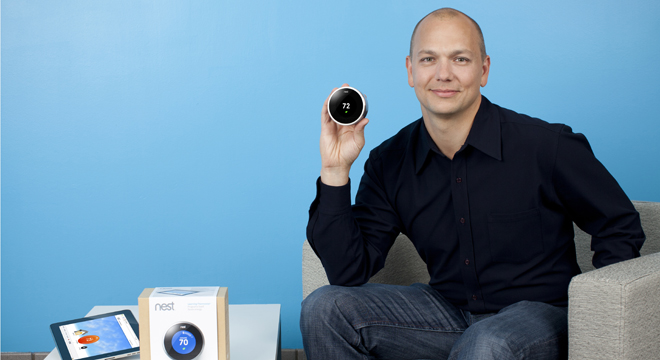The coveted new gadget of the moment isn’t a tablet, a new smartphone or anything of the sort. In fact, it’s none other than a programmable home thermostat.
At least, that’s the hope of the much-hyped Learning Thermostat unveiled Monday by Nest Labs, a new company founded by Tony Fadell, former senior VP of the iPod division at Apple, and the man credited with being the lead designer of the device and its corresponding iTunes service.
As Nest CEO Fadell wrote in a blog post announcing his new venture:
“Turns out you change the temperature in your house 1500 times a year. 1500! Our thermostat learns what temperatures you like so it can program itself. It senses when you’re out and turns itself down. And we started from scratch with design, so it’s beautiful. Gorgeous hardware, easy install, fully integrated software, remote control from your smartphone.”
Check out the first ad here:
The device costs $249 and is available for pre-order now in the U.S. only on the Nest website and from the Best Buy website (though both were having intermittent outages on Tuesday due to overwhelming traffic). It will begin shipping in mid-November, according to the New York Times.
Best Buy could not confirm or deny to TPM if and when the device would be available physically in retail locations. But Best Buy spokesperson Kelly Groehler told us that the company would be “making an important announcement about distribution channels of this and other products,” on Friday, November 4 at 11:30 ET.
Since the device debuted Monday night, it has received rave reviews from tech bloggers for its sleek, minimalistic design and intuitive, iPod-like user interface (there’s only two physical actions by which to interact with the device, turning the outside dial to adjust your home’s temperature settings and pressing down on the middle of the device to access its software menu options).
But the real innovation is under the hood, where Nest’s staff of 100, mostly mobile phone engineers, have developed an algorithm that they say “learns” a household’s activity patterns and automatically adjusts the temperature accordingly to save energy, lowering heating and cooling temperatures when occupants are away for extended periods of time. The “Auto Away” feature uses motion sensors to detect the presence and absence of occupants.
Another cardinal feature of Nest’s Learning Thermostat is the Leaf, a green leaf icon that appears on the thermostat every time the user manually switches the device’s temperature to a more energy-efficient setting, either using the dial on the outside or remotely from anywhere via a smartphone or tablet app. The goal is to subtly train people to be more energy efficient.
As Nest explains in a test simulation white paper on the Learning Thermostat: “The Leaf appears at different temperatures in different households, based on (1) the calculated efficiency of the household, (2) the HVAC system model and (3) the user’s prior behavior.”
The white paper also adds: “Using the simulation findings and weighting them across all U.S. zipcodes, it’s estimated that the Nest Learning Thermostat can save an average of$173 per year, before applying any of Nest’s additional energy-Ââ saving features such as Auto-ÂAway and the Leaf. In the future, the simulation data will be validated with field trials as well as with final units in homes. Modifications of the simulations will also be undertaken as needed.”
And yet, despite the rave early reviews, as numerous reports have pointed out, the device is over three times as expensive as other conventional programmable thermostats from such established industry names as Honeywell and Cadet. Of course, they don’t boast quite the slick interface or sophisticated algorithm as the Learning Thermostat.
Also, Fadell promises that the device will pay for itself in a year thanks to energy savings, potentially shaving 20 to 30 percent off an average household’s $1,000 annual energy bill, as CNET reported.
Even then, it faces an uphill climb to catch on with consumers. As Forbes‘ Michael Kanellos explains:
Tendril, EcoFactor and oPower have all begun to gain momentum in this market. Tendril is expected to soon announce mass deployment of its technology. All three, however, work with utilities, who subsidize all or part of the cost of the hardware and software. None are asking consumers to fork over $250.
The sales channel and buying patterns of Americans presents another challenge. People don’t buy thermostats. Electricians do–roughly 70 percent of them get purchased by installers, admits [Nest co-founder and VP of engineering] Matt Rogers. When do consumers get new thermostats? When they get new heaters, every few decades.
Still, Nest likely has enough venture capital funding to sustain it for at least the short-term, an estimated $50 million or more from Kleiner Perkins, Google Ventures, Lightspeed Ventures, Shasta Ventures, Intertrust, and Generation Investment Management, according to WIRED.
The timing of Fadell’s new venture is bittersweet by his own admission, coming so soon after the death of his former boss and friend Steve Jobs.
Fadell stepped down from his post as Apple senior VP of iPod back in 2008, but had remained on Apple’s payroll as a special adviser to Jobs until March 2010, when he left to start Nest Labs. As he told the New York Times at the time, “My primary focus will be helping the environment by working with consumer green-tech companies…I’m determined to tell my kids and grandkids amazing stories beyond my iPod and iPhone ones.
We’ve reached out to Nest Labs for further information on the Learning Thermostat and future projects and will update when we receive a response.









